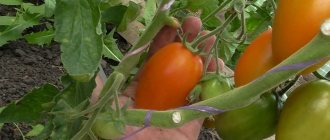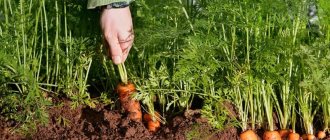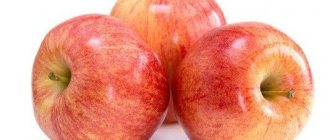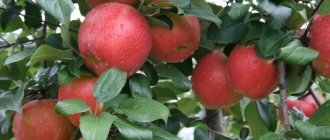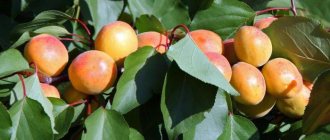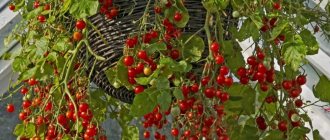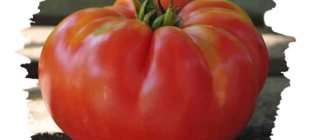Tomatoes "American ribbed": description of the variety
| Variety name | American ribbed |
| general description | Late-ripening, medium-growing variety of tomatoes for growing in greenhouses and open ground. |
| Originator | Amateur selection. |
| Ripening period | 120-125 days |
| Form | The fruits are strongly ribbed, flat-round or “bast” shaped. |
| Color | The color of ripe fruits is red. |
| Average weight of tomatoes | 300-600 grams |
| Application | Suitable for fresh consumption, for making sauces and juice, and canned whole fruits. |
| Productivity of the variety | 5.5 kg from 1 bush. |
| Features of cultivation | Sowing 65-70 days before planting. 3 plants per 1 square meter. Scheme - 50 x 40 cm. |
| Disease resistance | Complexly resistant to tomato diseases. |
American ribbed tomatoes are a determinate, standard variety of tomatoes.
In terms of ripening time, it is classified as mid-late or late-ripening, that is, 115-125 days pass from planting seedlings to the first ripe fruits. The plant is medium-sized - reaches a height of 120-150 cm. It has complex resistance to tomato diseases . It is recommended to grow in film shelters, in glass and polycarbonate greenhouses, and in open ground.
Fruits that have reached varietal maturity are red in color and strongly flattened in shape. The taste is bright, characteristic of tomatoes. They weigh 150-250 grams, when first collected they can reach 300-400 grams. The number of chambers is 6-7, the dry matter content is about 6%.
Ripe fruits are best eaten or processed immediately.
And in the table below you will find such characteristics as the weight of fruits of other tomato varieties:
| Variety name | Fruit weight (grams) |
| American ribbed | 150-250 |
| Kate | 120-130 |
| Crystal | 30-140 |
| Fatima | 300-400 |
| Explosion | 120-260 |
| Raspberry ringing | 150 |
| The Golden Fleece | 85-100 |
| Shuttle | 50-60 |
| Bella Rosa | 180-220 |
| Mazarin | 300-600 |
| Dad | 250-400 |
Landing
The ideal soil for growing a tomato variety is one that meets the following criteria:
- rich in potassium and nitrogen;
- soil temperature is warm;
- Ashes, shells and compost were added in the fall;
- Before the tomatoes were planted, cucumbers, parsley, cauliflower, carrots or zucchini grew on it.
Seedlings are planted in the ground after 2-3 leaves appear. When forming a bush into one branch and regularly removing excess foliage and stepsons, you can get larger fruits - from 0.5 kg and above.
Characteristics
“American Ribbed” was obtained through amateur selection. There is no exact data about the year of breeding, but it has been well known since the 1980s. Since then it has had its fans, primarily due to the appearance of both the bush itself and its fruits.
This variety will produce the best results in the south in open ground. In areas of the middle zone, it is better to hide it under film, then you can get a guaranteed harvest. In more northern parts, its cultivation is possible only in greenhouses.
The fruits of the American ribbed tomato variety are not suitable for whole-fruit canning, but can be used in barrel pickles. It will decorate any table with its appearance and taste. Very good for processing into juices, pastes and purees.
If you care for it properly, you can collect 2.5-3 kg of fruit from one bush. The recommended planting density for this species is 3-4 plants per square meter. m, thus comes out to 12 kg. This is an average result, not a record at all, but you can’t call it small either.
As for the yield of other varieties, you will find this information in the table:
| Variety name | Productivity |
| American ribbed | 12 kg per square meter |
| Banana red | 3 kg per square meter |
| Nastenka | 10-12 kg per square meter |
| Olya la | 20-22 kg per square meter |
| Dubrava | 2 kg per bush |
| Countryman | 18 kg per square meter |
| Golden Jubilee | 15-20 kg per square meter |
| Pink spam | 20-25 kg per square meter |
| Diva | 8 kg per bush |
| Yamal | 9-17 kg per square meter |
| Golden heart | 7 kg per square meter |
Photo
Photos of “American Ribbed” tomatoes can be seen below:
Advantages and disadvantages
Among the main positive qualities of the American Ribbed variety are:
- appearance of the fruit;
- resistance to lack of moisture;
- good immunity;
- good yield.
Among the disadvantages, it should be said that this species is quite capricious in terms of feeding , and if not properly cared for, it loses the taste of the fruit.
On our website you will find useful articles about high-yielding and disease-resistant varieties. You will also learn how to get a good harvest of tomatoes in open ground, how to do this in a greenhouse all year round, and what subtleties of growing early varieties know experienced gardeners.
Features of cultivation
Among the features of tomatoes of this type, it is worth mentioning the appearance of the fruits; they are very beautiful. Another feature is resistance to diseases inherent in tomatoes grown in greenhouses. Although it doesn’t hurt to know about measures to combat them and you can read about it here.
Read more on our website about tomato varieties resistant to major nightshade diseases. You may also find articles on determinate and indeterminate varieties useful.
Tomatoes are grown using the usual seedling method. After planting in a permanent place, standard care is required, do not forget about proper watering and mulching.
The trunk of the plant must be tied up; this will help protect the bush from gusts of wind; its branches need supports. Plants are formed into two or three stems. At all stages of growth it really needs complex feeding. Also does not really like acidic soils; neutral ones are best.
Read more about how to properly fertilize tomatoes with organic matter, how to use yeast, iodine, hydrogen peroxide, and ammonia for this purpose. And also how to use growth stimulants when planting and why tomatoes need boric acid.
Care
Throughout the entire period of growth and fruiting, American tomatoes must be constantly fed and fertilized, as they are quite capricious. If fertilizers are chosen incorrectly, the quality and quantity of fruits may suffer. The variety shows good productivity when growing in soil rich in potassium, nitrogen and natural organic matter.
When caring, do not forget to remove stepsons and excess foliage. It is advisable to carry out these manipulations 1-2 times a week so that the plant does not waste nutrients on maintaining unnecessary greenery.
Diseases and pests
"American ribbed" often suffers from fruit cracking. This scourge is easy to deal with, you just need to reduce the humidity in the environment. Tattu or Antrakol are successfully used against diseases such as dry spotting.
Against other types of diseases, only prevention is required, watering and lighting regimes, timely application of fertilizers; these measures will protect your tomato from all troubles. Read about tomatoes that are completely resistant to late blight here.
Of the pests, the most frequently attacked is the gnawing cutworm. This happens both in greenhouse shelters and in open ground. There is a reliable remedy against it, the drug “Strela”. To prevent the pest from becoming an uninvited guest again next year, you need to thoroughly weed the soil in the fall, collect insect larvae and thoroughly spray them with “Strela.”
May also be attacked by spider mites. To combat this pest, use a strong soap solution, which is used to wipe the areas of the plant that have been affected by the insect. By washing them away and creating an environment unsuitable for their life. This will not cause any harm to the plant.
Transplantation into open ground
Before transplanting seedlings, well, cover the soil with film for several days. Thus, the beloved will warm up, and the tomatoes will begin to grow much faster in open ground.
Before planting, the stem must be slightly deepened. During rapid growth, tomatoes form additional roots. The more soil participates in the formation of the root system, the more complete the enrichment with nitrogen. And also during dry periods, the plant will better absorb water from the soil.
If the stems are too long, they can be partially placed in a previously prepared groove. The fucking way helps the plant increase its root system, which will improve the homogamy of the fruits.
